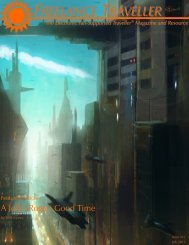Doing It My Way - Freelance Traveller
Doing It My Way - Freelance Traveller
Doing It My Way - Freelance Traveller
You also want an ePaper? Increase the reach of your titles
YUMPU automatically turns print PDFs into web optimized ePapers that Google loves.
<strong>Doing</strong> <strong>It</strong> <strong>My</strong> <strong>Way</strong><br />
(Continued from page 22)<br />
other purely electronic tasks twice as fast as users<br />
limited to ordinary computer interfaces, like hand<br />
computers.<br />
TL 11 Equipment<br />
Camera Jewelry (TL 11): Usually worn with<br />
contact lens display, camera jewelry consist of a<br />
pair of ear rings, a pendant, choker, or some other<br />
item of jewelry worn on or near the user‘s head that<br />
contains one or two miniature camera and microphones,<br />
as well as small speakers to provide sound<br />
for the user. The cost of this device is included in<br />
the price for a wearable interface using a contact<br />
lens display.<br />
Cost: Cr 300<br />
Contact Lens Display (TL 11): Using microcircuitry<br />
embedded in extended wear contact<br />
lenses, this device provides all of the visual display<br />
capabilities of display glasses. However, an external<br />
speaker must be used and if augmented reality<br />
is desired, the user must also wear camera jewelry.<br />
Cost: Cr 300<br />
Display Viewers (TL 11): This device combines<br />
the function of display glasses and electronic<br />
image viewers. Using advanced cameras and enhanced<br />
data display, these viewers function as ordinary<br />
display glasses, while also working as electronic<br />
viewers that allow the user to see clearly in<br />
the IR, visible, and UV spectral bands, as well as<br />
using light intensification to provide night vision.<br />
Automatic dimming and image polarization eliminates<br />
glare and dims down overly bright lights. In<br />
addition, the camera on this unit also permits magnification<br />
of up to 10X, which can be used as both<br />
binoculars and a low power microscope. The unit<br />
also contains a laser range-finder with a 1 km<br />
range. This device duplicates the functions of Image<br />
Convertor Binoculars (Mega<strong>Traveller</strong> World<br />
Builder‟s Handbook (DGP), p. 21).<br />
Cost: Cr 800<br />
Improved Camera Jewelry (TL 11): This improved<br />
version of camera jewelry includes all of<br />
the capabilities of display viewers, including seeing<br />
in the IR – UV spectrum, light intensification, automatic<br />
dimming, 10X magnification, and the laser<br />
range finder. Advanced camera jewelry is often<br />
used in combination with interface implants, neural<br />
interfaces or computer implants.<br />
Cost: Cr 1,000<br />
Microdrone (TL 11): This tiny robot is the<br />
size and shape of a small humming bird 6 and flies<br />
in a very similar manner. <strong>It</strong> is 4 cm long, 1 cm in<br />
diameter, with a 5 cm wingspan. Far too small to<br />
use gravitics, this diminutive robot flies using<br />
wings and high density batteries. <strong>It</strong> contains a tiny<br />
High Data computer identical to the one used for a<br />
wearable interface, as well as cameras, microphones,<br />
and speakers identical to those on display<br />
viewers or advanced camera jewelry. This robot<br />
can be controlled via a radio link or it can be given<br />
simply orders to follow a single person or to scout<br />
a specific area. <strong>It</strong> is effectively silent and at the<br />
user‘s option, its color changing paint can transform<br />
from a bright color scheme that makes it<br />
highly visible to matching its color to its surroundings,<br />
rendering it difficult to see (increase the Difficulty<br />
Level to see this robot by 1).<br />
Microdones fly at a speeds of up to 50 kph and<br />
can operate for up to 12 hours without recharging.<br />
They can maintain encrypted radio contact via cellular<br />
data networks or via a two way radio with a<br />
range of 100 km. This robot can only fly in Thin,<br />
Standard, or Dense atmospheres. Versions designed<br />
to swim underwater, with top speeds of 20<br />
kph are made for the same price. A microdrone can<br />
be controlled by a hand computer, wearable interface,<br />
or similar device.<br />
Cost: Cr 1,000<br />
Mini-Sensors (TL 11): These devices are powerful<br />
sensors in very small packages 7 . Although<br />
there are many varieties, two are most commonly<br />
used by interstellar travelers – gas sensors and<br />
chemical sensors. Both devices are designed to<br />
communicate with the user‘s hand computer or<br />
other portable computer (including interface implants<br />
and neural interfaces). Users obtain the information<br />
acquired by these sensors from their<br />
hand (or other) computers and can use these computers<br />
to request specific types of sensor scans. TL<br />
10 versions of both types of sensors exist, but are<br />
(Continued on page 24)<br />
23

















